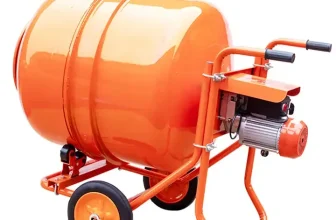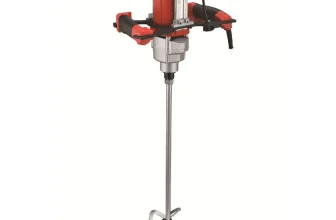Concrete mixers are essential pieces of equipment for building and construction projects. They are used to mix cement, sand, gravel and water in order to create concrete. Three point hitch concrete mixers are designed to be connected to the back of a vehicle such as a tractor or ATV so they can be transported to different work sites.
These portable units make it easier to move materials around, saving time and money. They have become increasingly popular due to their versatility and convenience.
In this article we will explore the different types of 3 point hitch concrete mixers available on the market, their advantages and disadvantages as well as operating and maintenance considerations.
Types of Concrete Mixers for 3 Point Hitches
Front Mounted Mixers
Although they are not nearly as common as rear 3 point hitches, there are some tractors that have them. There are also aftermarket kits available for purchase that can add a 3 point hitch, including a PTO (power takeoff), to the front of many tractors.
A front mounted mixer is a type of 3 point hitch concrete mixer that is attached to the front of a vehicle such as a tractor.
This type of mixer has the advantage of being able to be positioned close to the ground, making it easier to access materials and reduce physical exertion on the operator.
They are more maneuverable than rear mounted mixers in most cases, providing better control over where material can be placed.
There are some disadvantages to using this type of mixer, such as increased weight on the front axle which can affect handling and may require additional counterweighting for stability.
This additional weight is usually due to the fact that most tractors and ATVs do not have a PTO (power takeoff) on the front. Because of this, front mounted concrete mixers need to have a motor integrated into them to power the mixer.
Rear Mounted Mixers
Rear mounted concrete mixers are a type of construction equipment used to mix cement, aggregate, and water to create concrete.
These mixers are typically mounted on the back of a truck or tractor and have a rotating drum that mixes the components together. They are normally operated by the PTO (power takeoff) if the vehicle is equipped with one.
Rear mounted concrete mixers offer several advantages over front mounted ones.
One advantage is that they can usually be operated from the cab of the truck or tractor, allowing for more efficient operation. This also eliminates the need for someone to manually operate the mixer from outside the vehicle.
Rear mounted mixers are better suited for off-road use due to their higher ground clearance and improved traction.
Rear mounted mixers often have larger drums than front mounted ones, allowing them to produce more concrete in less time.
Nice to Have Accessories
Hydraulic Top Link
Once nice accessory that will add a lot of value to a three point cement mixer is a hydraulic top link.
Adding a hydraulic top link to your three point hitch will allow you to dump the mixed concrete without getting off the tractor when you have a mixer attached. This is a very nice feature to have, and hydraulic top links are usually not too expensive.
Operation and Maintenance
It is important to make sure a 3 point concrete mixer, or any other machinery, is properly maintained and operated.
This is important to make sure the mixer works properly and has the maximum usable life. It also reduces dowtime and repair costs since it will help ensure the mixer does not break down as much.
Pre-Use Inspection
One important part of the operation and maintenance of a three point hitch concrete mixer is the pre-use inspection. This step should be done each day before the mixer is operated.
Pre-use inspection is a critical step for ensuring the safety and performance of any industrial machinery.
Here are the steps involved in pre-use inspection:
- Check all exposed surfaces such as cables and hoses for fraying or damage.
- Inspect all bolts, nuts, and screws to ensure they are properly secured.
- Examine all controls to ensure they are in proper working order and there are no loose wires or connections.
- Make sure all guards and covers are in place and working correctly.
- Verify that the machine is properly lubricated with fresh oil or grease, if necessary.
- Test run the machine at low idle speed before loading material into it to make sure everything works as expected.
Proper Mixer Operation
Proper operation techniques for industrial machinery is essential for ensuring safe and efficient performance. Here are some key tips for proper operation:
- Read the operator’s manual thoroughly before use to become familiar with all safety protocols and instructions.
- Wear protective gear such as glasses, gloves, and a hard hat when operating the machine.
- Follow the manufacturer’s instructions for loading material into the machine, as improper loading can damage it or cause injury.
- Pay attention to any alarms or warnings that may be triggered while using the machine, as these are indicators of potential problems that should be addressed immediately.
- Make sure to check all gauges on a regular basis in order to detect any changes in pressure or temperature that could indicate an issue with the machine’s performance or safety systems.
- Monitor all belts and moving parts regularly to ensure they are running correctly and not misaligned or slipping.
- Ensure the area is well ventilated when using any concrete mixers with gasoline or diesel powered engines, as these produce hazardous exhaust fumes.
- Make sure to never overfill the mixer, as this can cause the container to become unbalanced and become more difficult to operate safely.
Concrete Specific Safety Precautions
When mixing concrete, there are a few key safety considerations to keep in mind:
- Wear protective gear such as gloves, long sleeves, and goggles to protect yourself from the dust and chemicals.
- Use a respirator or dust mask to prevent inhalation of any silica-based particles that may be present in the concrete mixture.
- Use proper lifting techniques when transferring concrete from one area to another, such as keeping the back straight and using the legs when lifting.
- Avoid adding water directly onto dry material in order to avoid creating too much dust and making it more difficult for the materials to blend properly and evenly during mixing.
Conclusion
When it comes to mixing concrete, safety should be paramount. It is important to wear the right protective gear at all times, use good lifting techniques, and keep all equipment in good working order.
Be sure to not overfill the mixer and avoid adding too much water directly onto dry material. By taking these precautions when handling concrete you can ensure a successful and safe mixing process every time.






